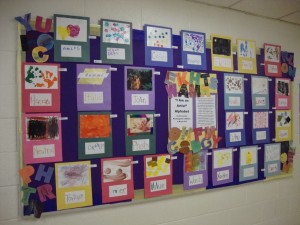“The alphabet was one thing when applied to clay or stone, and quite another when set down on light papyrus.” ~ Marshall McLuhan
 I have long been fascinated by the different pencil grasps that children use as they learn to make marks on paper and print letter symbols. I looked at web links that introduced me to the names for the different grasps, explained the developmental sequence that these grasps follow and suggested ways to support this development. Occupational Therapy for Children provides some helpful information and images of different grasps. I noticed that some children in my class were “reluctant writers” who did not tend to visit the writing table or the art table. In order to address this situation, I decided to initiate a special project with the children in junior kindergarten, with the goal of engaging their interest in alphabet letters, words and printing through the exploration of different visual art experiences.
I have long been fascinated by the different pencil grasps that children use as they learn to make marks on paper and print letter symbols. I looked at web links that introduced me to the names for the different grasps, explained the developmental sequence that these grasps follow and suggested ways to support this development. Occupational Therapy for Children provides some helpful information and images of different grasps. I noticed that some children in my class were “reluctant writers” who did not tend to visit the writing table or the art table. In order to address this situation, I decided to initiate a special project with the children in junior kindergarten, with the goal of engaging their interest in alphabet letters, words and printing through the exploration of different visual art experiences.
In addition to allowing the children to strengthen the small muscles in their hands, it enabled them to practise their grasp on a variety of art materials. For example they used brushes, rollers, pens, pencils, bingo dabbers, markers, Q-tips, crayons, pastels and glue sticks. They also became acquainted with different art terms ranging from names of different colours (e.g., umber), to techniques (e.g., montage), to subject matter (e.g., family), to materials (e.g., glitter). Much inspiration for this project came from The Visual Arts Vocabulary Word List and The Art Glossery of Terms where I found words that showed me a variety of inventive possibilities for art activities with the children. This experience certainly expanded my own arts vocabulary, and encouraged me to introduce children to unusual new words.
enabled them to practise their grasp on a variety of art materials. For example they used brushes, rollers, pens, pencils, bingo dabbers, markers, Q-tips, crayons, pastels and glue sticks. They also became acquainted with different art terms ranging from names of different colours (e.g., umber), to techniques (e.g., montage), to subject matter (e.g., family), to materials (e.g., glitter). Much inspiration for this project came from The Visual Arts Vocabulary Word List and The Art Glossery of Terms where I found words that showed me a variety of inventive possibilities for art activities with the children. This experience certainly expanded my own arts vocabulary, and encouraged me to introduce children to unusual new words.
The result of our project was that each of the children created their own “I am an Artist” alphabet book, complete with twenty six works of art, along with the accompanying words they had printed. Below is the list of words, and the materials that were used to create the art. I hope you find ideas here that inspire an inventive alphabet project of your own!
Apples (apples and tempera paint)
Blots (bingo dabbers)
Circles (round stickers)
Doodle (markers)
Ebony (sponges, tempera paint)
Family (markers)
Glitter (glitter, glue, glue sticks)
Hands (tempera paint)
Italic (pencil crayons)
Join (magazine pictures, tape)
Khaki (tempera paint, sponges, rollers)
Lines (markers)
Montage (magazine pictures, glue)
Neutral (black, white, brown and grey pastels)
Orange (tempera paint and tissue paper)
Photo (photographs, stickers and markers)
Q-tip (tempera paint, Q-tips)
Relief (linocut, roller, tempera paint)
Squares (origami paper, glue)
Texture (textured squares, crayons)
Umber (tempera paint, sponges)
Value (paint chips, glue)
Wash (crayons, brushes, watercolour paint)
Xanthic (yellow paint, lids, glitter)
Yellow (highlighter pens, yellow tags)
Zigzag (markers)
This blog post is in memory of my dear friend Professor Monique Richard, who passed away on May 14, 2016. She taught me much about early literacy, and how to find creative ways to encourage children’s love of reading and writing.


Lovely and well-presented article. I like the way you share and describe the different pencil grasp. And the project you suggested and listed above is beneficial as you put in open and closed parenthesis the materials that are needed.
Thanks for sharing!